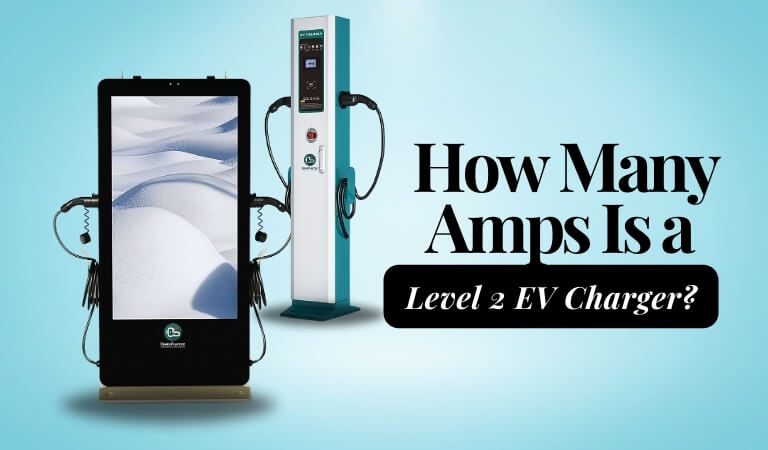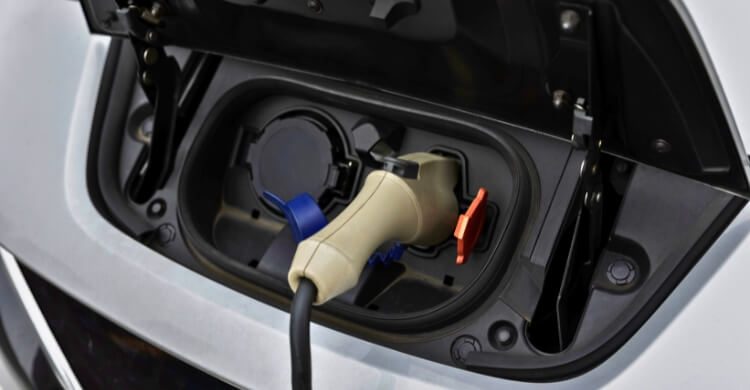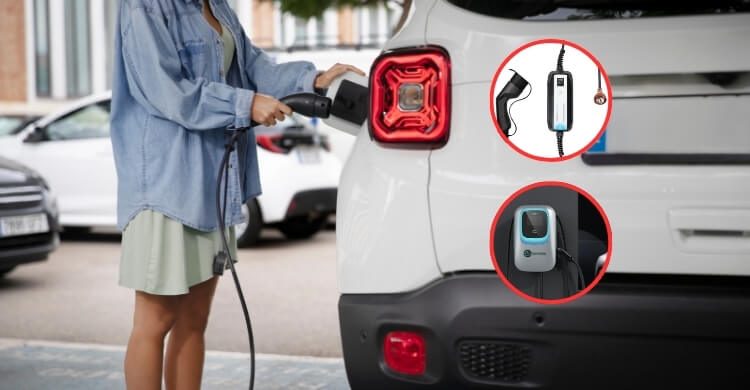As electric vehicle (EV) adoption has grown in recent years, charging infrastructure has become increasingly important. To maximize charging speed, compatibility, and safety, it’s essential to understand the power capabilities of different EV chargers. Among them, Level 2 EV chargers stand out.
This type of charger is a popular upgrade from Level 1 units, offering a significant boost in charging efficiency. Whether you’re installing a home charging station or using a public setup, being aware of their power output is key. So, how many amps is a Level 2 EV charger?
A Level 2 EV charger typically delivers between 16 to 80 amps, depending on the model and setup. This allows for faster charging compared to Level 1 chargers, providing a more efficient and quicker way to charge electric vehicles at home or at public charging stations.
If you would like to learn more about what affects the amperage of an electric vehicle, how to choose the right charger, and what this means for electric vehicles, continue reading.
How Many Amps is a Level 2 EV Charger?
Level 2 EV chargers are stronger and faster than regular ones used at home. These chargers can give between 16 to 80 amps, depending on the type. That means they can charge an electric car in a few hours instead of overnight. But the exact amperage depends on a few important things.

Charger Model and Design
Each charger comes with its own built-in power range. Some are made for smaller cars, others for larger vehicles. Basic models often offer 16 to 32 amps. High-end models can deliver up to 80 amps. Always check the label or manual for exact details.
Installation Setup
The way a charger is installed affects how many amps it can give. A strong circuit can handle more power safely. Poor setups might limit output to prevent overheating. Electricians usually set it based on your home’s wiring. Safe installation always comes first before full power.
Vehicle Charging Capacity
Not all electric cars can accept high amps. Some vehicles are made for slower charging. Even if the charger gives 80 amps, the car may only take 32. The charger will match the car’s limit. Always check your vehicle’s manual to know its maximum intake.
Circuit Breaker Size
Your home’s circuit breaker decides how much power goes to the charger. Bigger breakers support higher amp chargers. A 40-amp breaker might run a 32-amp charger. You’ll need a 100-amp breaker for an 80-amp charger. Choosing the right breaker keeps things safe and smooth.
Wire Gauge Used
The thickness of the wire matters a lot. Thicker wires can handle more electricity. When wires are thin, they can overheat at high amps. In countries like Bangladesh, where the power grid and weather conditions can vary, it’s crucial to select the right wire. A reliable EV charging service provider in Bangladesh can guide you in choosing the appropriate wire for safe and efficient installation.
Charging Habits and Location
How and where you charge can impact amp needs. Charging overnight at home may not require high amps. Public stations often give more power quickly. Hot or cold weather may change how fast you charge. Pick your charger based on your daily driving and location.
High-Amp Chargers vs. Standard Models: What’s Right for You?
Electric vehicles are becoming more common on roads around the world. One important part of owning an EV is choosing the right charger. Let’s explore the difference between high-amp chargers and standard models to help you make a smart choice.

Charging Speed and Daily Needs
High-amp chargers fill your battery much faster than standard models. They are helpful if you drive long distances every day. Quick charging saves time and gets you back on the road sooner. For people in a rush, this makes a big difference.
Standard chargers work well for slow, overnight charging. They are better for people who don’t drive far each day. This option suits relaxed schedules and lower energy needs. It’s perfect if your car sits overnight anyway.
Home Power Capacity
A high-amp charger needs strong electrical wiring at home. Not every home has the setup to support high power safely. Installing it might need upgrades to your electric panel. That can cost more and take some planning.
Standard models are easier to install in most homes. They use less electricity and work with common household wiring. It’s a better fit for older homes or shared buildings. You save money on setup and avoid big changes.
Vehicle Compatibility
Not all EVs can handle high-amp charging. Your car might only take a limited amount of power. Using a high-amp charger doesn’t help if the car can’t accept more. Always check your vehicle’s manual or talk to the dealer.
Standard chargers match well with most electric cars. Many entry-level EVs are built for lower amp charging. This makes a standard charger a safe and useful option. You get good results without spending extra for unused power.
Cost and Long-Term Value
High-amp chargers cost more to buy and install. But they offer faster charging and long-term flexibility if you upgrade your car later. The speed and power may be worth the price. It’s an investment for future needs and convenience.
Standard models are more budget-friendly for most families. They cover daily needs without pushing your power system. If you plan to keep your current car, it’s a smart choice. It saves money now while meeting basic charging needs.
Lifestyle and Location Factors
Your daily habits matter when picking a charger. If you drive a lot or live far from public stations, faster charging helps. High-amp chargers suit busy people who need quick top-ups. They’re also great for areas with fewer charging spots.
Standard chargers are better if you live in a city or work from home. They fit into slower lifestyles and local travel. In colder regions, the impact of cold weather on EV charging can slow down battery performance, which makes overnight charging even more practical. Think about your schedule and how often you need a full battery.
Is Amperage Affecting Your Electric Bill While Charging Your EV?
Yes, amperage does affect your electric bill when charging an EV, but how much depends on your usage and setup. More amps mean faster charging, but they also pull more power in a shorter time. Even if you charge quickly, the energy used still shows up on your monthly bill.
Charging at higher amperage doesn’t always mean it’s more expensive overall. If you charge during off-peak hours, your cost can stay lower. The electricity rate matters more than just the speed of the charge when looking at your bill.
A lower-amp charger may take longer, but it spreads the energy use over time. That can help avoid peak pricing in some areas. Paying attention to your usage, time of charge, and amperage can help control your bill easily.
What Happens When an EV Charger Delivers More Amps Than Needed?
Vehicles that run on electricity can handle varying charging levels safely. Many people wonder what happens if the charger gives more power than is needed. Let’s break down what really happens in that situation and whether it’s safe or wasteful.

The Car Controls the Flow
The electric vehicle decides how much power it needs during charging. The car limits the intake based on need. Even if the charger offers more, the car controls what it accepts. This prevents damage and keeps the battery safe during charging.
No Wasted Electricity Happens
If the car doesn’t need the extra amps, they aren’t used. The charger gives more, but the car won’t accept it. Only the required power is used, and nothing is wasted. In this way, only the electricity consumed will appear on your energy bill.
Built-in Safety Features Work Well
Modern EVs have safety features that protect the battery from excess power. These systems ensure that only necessary amps are used. The charger adjusts the power flow to match the car’s needs. This prevents overheating or any possible damage during charging.
Charger Still Runs Normally
The charger continues to operate even if more amps are available than needed. It adjusts the power output automatically. There is no harm to the charger or cables when such a thing happens. The system runs smoothly and adjusts as needed for safety.
Charging Speed Stays the Same
Even if the charger offers more amps, the charging speed doesn’t increase beyond the car’s capacity. The vehicle limits the charging rate. The charger’s power capacity doesn’t directly affect the vehicle’s charging speed. It ensures safe and efficient charging, regardless of the amp rating.
When Should You Upgrade to a Higher-Amp Level 2 Charger?
Upgrading to a higher-amp Level 2 charger can bring faster and more efficient charging for your electric vehicle. Knowing when it’s time to upgrade can save you time and money. Let’s take a closer look at the factors that help determine when it’s the right time to make the switch.
Driving More Miles Every Day
Long daily drives require faster charging sessions to keep up. A low-amp charger may take too long to refill the battery. More amps mean less waiting between drives. Quick charging helps maintain regular routines without delays or stress.
Switching to a Larger EV Model
Bigger EVs often need more energy to charge fully. Some models accept higher amps for faster charging at home. Using a low-amp charger may slow down the process. A higher-amp charger better supports your vehicle’s bigger battery size.
Sharing One Charger Between Multiple EVs
Families or homes with more than one EV may share a single charger. High-amp chargers reduce wait time for the next vehicle. Charging two cars daily requires a faster turnaround. Upgrading saves time and helps manage multiple vehicles with ease.
Experiencing Charging Delays During Peak Hours
During busy hours, electricity use is often more expensive. Charging faster helps avoid peak rates and higher bills. By understanding the essential components of EV chargers, you can choose one that delivers the most power. When using a higher-amp charger, the charge is finished before the rates return to normal.
Planning for Long-Term EV Use
A higher-amp charger supports future vehicle upgrades without changing the equipment again. Some upcoming EVs will require more powerful charging setups. Upgrading early helps avoid extra costs later. It’s a smart move for long-term planning and flexibility.
FAQs About How Many Amps Is a Level 2 EV Charger?
There is no doubt that Level 2 chargers have become more popular among electric vehicle owners, especially because of their power and performance. Below are some answers to common questions beyond what we have already discussed.
Can a Level 2 EV charger Be Used With Solar Power?
Yes, a Level 2 EV charger can be powered by a solar energy system if it’s properly sized and installed. Many homeowners use solar to reduce charging costs and carbon emissions. You’ll need a solar inverter that supports the charger’s amp load. Solar setups with battery storage can also provide backup power during outages.
Is It Safe to Use a High-amp Charger in Rainy Weather?
Yes, Level 2 chargers are built to withstand outdoor conditions, including rain. They are weatherproof and meet strict safety certifications. The connectors and housings are sealed to prevent water damage. Always follow installation guidelines to ensure safety, especially when placing the unit outdoors.
What Role Does the EV’s Onboard Charger Play?
The onboard charger inside your EV controls how much amperage it can accept. Even if the external charger provides more amps, your car may limit intake. This built-in cap prevents overcharging and ensures battery safety. Always check your EV specs before selecting a charger.
Can Charging at Lower Amps Increase Battery Life?
Charging at lower amperage may extend battery life by reducing heat and stress during the process. It’s gentler on the cells over time. Some EV owners choose to slow-charge overnight to support long-term battery health. However, this method takes more time.
What Happens If Your Home Panel Can’t Support High Amps?
If your electrical panel can’t support a high-amp charger, it may trip breakers or fail to power the unit. You might need a panel upgrade. A licensed electrician can assess load capacity and recommend changes. It’s important for safety and full charging performance.
Can Amperage Be Affected By Voltage Fluctuations?
Yes, inconsistent voltage can impact how much amperage your charger delivers. Lower voltage may reduce charging speed and efficiency. A stable power supply ensures consistent performance. Voltage regulators or dedicated circuits can help improve stability in sensitive areas.
Final Thoughts
Your daily routine and your long-term experience with electric vehicles can be greatly impacted by the kind of charger you choose. In comparison to Level 1 chargers, Level 2 chargers offer faster charging and more flexibility. They are suitable for a range of vehicles and user needs.
When asked, “How many amps is a level 2 EV Charger?” the answer ranges from 16 to 80 amps, depending on the model, setup, and car compatibility. Factors like installation, wire size, and your car’s charging capacity also affect performance.
No matter whether you’re upgrading to handle more miles, multiple EVs, or future-proofing for newer models, understanding your needs is key. With the right information and setup, you can ensure efficient, safe, and reliable charging at home and on the go.
